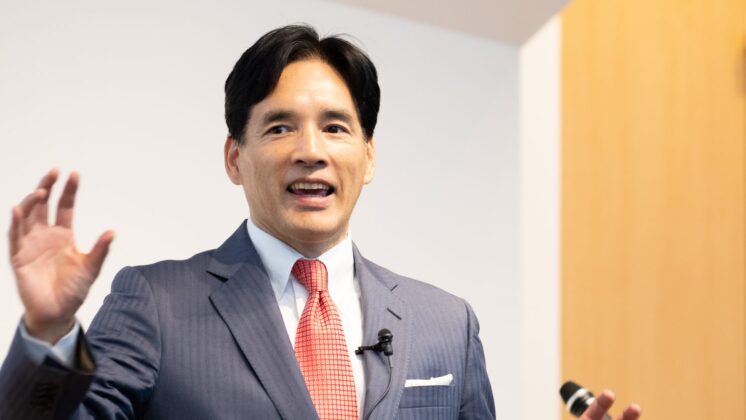On Tuesday, I flew to Dalian, China, where the World Economic Forum’s Inaugural Annual Meeting of the New Champions was scheduled to be held. This meeting is also known as the “Summer Davos” and expected to draw almost 2,000 participants from around the world.
I decided to arrive in Dalian a day early. On the day I got there, I relaxed by swimming, enjoying seafood dishes, and getting a massage, among other things.
The next day, I decided to do some sightseeing in Dalian and Lushun. To be honest, if I had a choice, I would have liked to visit Shenyang (Mukden) and Changchun (Xinjing) to see sites of the Japanese governance over Manchuria, but unfortunately, I did not have the time. On this trip, I decided to explore Dalian, which had been the foothold for Japan to establish Manchukuo and Lushun, the site of a hard-fought battle in the Russo-Japanese War. Being an enthusiastic fan of Clouds above the Hilltop, a novel written by Ryotaro Shiba, I really wanted to see 203 Meter Hill and Lushunkou (Port Arthur) with my own eyes.
I arranged to meet a driver and a tour guide in the hotel lobby. The hotel was already under tight security due to the Davos meeting.
The guide was a Chinese lady in her late 20s from Shenyang. She had lived in Osaka for several years. In the car on the way to Lushun, I asked her about Dalian, Japan’s colonial policies, and the war, as well as life in Osaka.
I recall reading an article somewhere long ago that said students who come to Japan return to their countries with an anti-Japanese feeling. The issue has been on my mind ever since, so I always ask overseas students if they enjoyed their time in Japan. In my own experience up to now, I have met few people who say that they don’t like Japan after having studied there, but maybe times have changed. I also ask similar questions to businesspersons who have lived in Japan. They all tell me that it was a great experience for them. I have a feeling that the number of Japan fans is growing.
This guide was no exception. She assured me that she had a great time in Japan and would like to visit again. “The truth is,” she said, “I wanted to stay in Japan, but since I am an only child, my parents asked me to return home. So I had no choice.” She said she was from the first generation of the one-child policy.
We drove west from the city of Dalian, heading for Lushun. On the way, we passed several Technological Development zones, including a software park. This area was relatively mountainous, covered with patches of trees.
The guide taught me about the four things you rarely find in Dalian:
· Bicycles, because of the mountainous terrain
· Garbage, since residents take turns to keep everything clean
· Rain, which I could readily see for myself, since the mountain surface was barren
· Traffic lights, since cars had the right-of-way in this town
We reached the foot of a mountain and arrived at the Northern Blockhouse in East Jiguanshan Hill. The ruins of a Russian fortress are here. In the Russo-Japanese War in 1904, Japanese forces attacked the Russian defenders here twice. In the first attack, the Japanese units were totally crushed, but on the second assault, Japanese forces completely destroyed the Russian troops by digging a tunnel and attacking from underground. I caught a glimpse of the fierceness of the battle from the cannon and bullet shell marks left on the walls. Taking control of these hills enabled the Japanese forces to attack 203 Meter Hill with artillery.
We then arrived at the Shuishiying meeting place. After Russian troops in Lushun surrendered on January 2, 1904, General Maresuke Nogi and Major-General Anatoly Stoessel met here. It was originally a farmer’s house, but Japanese troops used it as a field hospital. The desk used at the meeting had previously served as an operating table, and there is a large description of the meeting in Japanese on the surface.
Finally, we went to 203 Meter Hill. We went halfway up by car, then walked the rest of way. After going up a mild slope for about 15 minutes, we arrived at the summit. Here, a cenotaph soars into the sky. It is said that General Nogi picked up shells and bullets himself to have the tower forged in Yamaguchi, his hometown.
When I happened to glance right, Lushunkou spread out before me. After taking over 203 Meter Hill on December 5, 1904, Japanese troops mounted a battery with an 8-kilometer range and bombarded the Russian fleet anchored in Lushunkou, 7 or 8 kilometers away.
The Japanese navy, led by Commander Takeo Hirose, had previously sunk ships at the entrance of Lushunkou to blockade the port and prevent the Russian fleet from leaving. None of the Russian warships could escape.
As a result, Russian troops in the Far East surrendered, and General Nogi and Major-General Stoessel met at Shuishiying. The war continued and led to the battle in the Japan Sea, with the Baltic Fleet arriving via the Indian Ocean.
The view of Lushunkou from 203 Meter Hill is spectacular. I stood there for a while pondering how General Nogi must have felt presented with this view.
Eventually, the guide suggested that it was time to leave, so I offered a prayer to the cenotaph and reluctantly left the summit. On the way down, we stopped at the place where General Nogi’s second son died. The mountain is now covered with trees, leaving no trace of this place having once been a battlefield. It was the same mountain landscape you could find anywhere.
After coming down the hill, I visited the Lushun Museum, which was built as the former Japanese Kwantung Government museum in 1917. This grand building housed a substantial collection in terms of both quality and quantity. There are over 80,000 items in this museum, including a particularly extensive collections of Buddha statues and heads, currency, lacquerware, and bronze mirrors collected from Dunhuang and other places in Central Asia. Many were collected by Kozui Otani, the head priest of Nishi Hongan-ji Temple. A Japanese emblem still appears on the showcase. In their original cases, the items are displayed as they used to be. I could genuinely feel history here and was grateful to the museum staff for their explanations in fluent Japanese.
I returned to Dalian for lunchーdumplings, of course! Meals in China are very cheap. A plate of dumplings costs a little over 100 yen. After lunch, we went sightseeing in Dalian.
First, we visited the head office of the South Manchuria Railways, founded in 1906 after the Russo-Japanese War. Under Shimpei Goto as the first president, who had been head of civilian affairs in Taiwan, the company was the core entity in colonial management. Its head office was located in Dalian, inside a building originally built as a Russian school. On the street, I found a manhole cover engraved with the emblem of the South Manchuria Railways.
In the history of Dalian, the Russians created the overall design, the Japanese built the infrastructure, and the Chinese modernized the city. It’s a place with a very exotic atmosphere.
Next, we headed to the former Yamato Hotel in Zhongshan Square. This square was located in the center of Dalian during the Manchukuo era. Although it’s called a square, it’s really circular with a diameter of about 100 meters. Ten roads run through it, forming circles that radiate outward.
The buildings standing between these ten streets were built by the Japanese during the Manchukuo colonial era. They are sumptuous and sturdy, remaining just as they had been originally. Today they are operated by Chinese businesses. The former Yokohama Specie Bank is now the Bank of China; the Yamato Hotel, built by the South Manchuria Railways, is now the Dalian Hotel; and the Dalian Police Office is now the Liaoning provincial government building.
Inside the Yamato Hotel, there was an absolutely gorgeous marble floor and chandelier. The interior displayed the Western style of Japan’s Meiji Era.
After Zhongshan Square, we visited the former Japantown, a quiet residential area with a row of mansions gracing gentle slopes. Perhaps many Japanese senior officers, government officials, and financiers once lived here. I wonder what thoughts they had when they moved here from Japan. I could feel myself traveling back in time 100 years.
When visiting former Japanese colonies such as Korea and Taiwan, I have rarely felt how it was in the colonial era under Japan’s governance. In Seoul, I could see vestiges of Japanese influence in train stations, city hall, and the universities, which were built after the office of the Japanese Governor-General of Korea was torn down. The situation in Taiwan was similar. But neither of these places had as strong a Japanese influence as Dalian and Lushon, perhaps because Japan had not engaged in battles in Korea and Taiwan, or because many Japanese actually came and lived in Manchuria. Or maybe the traces of Japan’s colonial rule had been destroyed elsewhere.
I don’t know the reasons for sure, but I could feel the spirit of Japan’s Meiji Era in this place. I could sense it from the presence of Western-style buildings built by the Japanese and the size of Japanese houses, as well as battlefield monuments and their inscriptions.
Ryotaro Shiba recreated events up to the Russo-Japanese war as historical novels, but he didn’t write about the history of Japan after that period. I felt the traces of many people, including the Akiyama brothers, who had fought to protect Japan from a Russian advance to the south. The spirit to create a new country remains strong in Dalian and Lushon.
In the evening, I returned to the hotel. Student volunteers were working hard to prepare for the Davos meeting. The first dinner of the conference was scheduled to be held here as a private affair hosted by Klaus Schwab, the founder of the World Economic Forum, which organizes the Davos meetings. I changed into a suit and quickly headed to the banquet hall. Feeling refreshed by the real-life landscape of Clouds above the Hilltop, I opened the door to the first venue of the inaugural Summer Davos.



